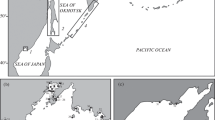Abstract
Bacteria were present in the majority of clonal sea star bipinnariae (Luidia sp.) collected between June 1987 and August 1990 from oceanic populations in the subtropical western North Atlantic Ocean. Light and electron microscopy revealed dense aggregations of bacteria within lobes of the epidermal cuticle in the gastric region of larvae. Gram-negative rods and less-common elongate spiral bacteria were observed, always in close association with branching epidermal microvilli. Intact and partially digested bacteria occurred in vesicles and phagosomes within epidermal cells, a probable indication of phagocytotic activity by the host. The association of larvae of Luidia sp. and bacteria ranged widely on both geographical and temporal scales. During July and August 1988, larvae were abundant (1.6 to 11.1 m3) in the mixed surface layer (<10 to 100 m) of stations in the Gulf Stream, the Sargasso Sea and the North Equatorial Drift, and ∼96% (mean of 5 stations, n=8 to 10 larvae in each station) of the individuals surveyed harbored bacteria beneath their cuticle. In a single station on the Florida Current sampled during winter, spring, and summer months between 1989 and 1991, 79 to 90% of the larvae harbored bacteria. The incidence of symbiosis was higher in actively cloning larvae than in non-cloning larvae. This is the first documentation of a symbiosis in field populations of echinoderm larvae.
Similar content being viewed by others
Literature cited
Banse, K. (1986). Vertical distribution and horizontal transport of planktonic larvae of echinoderms and benthic polychaetes in an open coastal sea. Bull mar. Sci. 39: 162–175
Bosch, I., Rivkin, R. B., Alexander, S. P. (1989). Asexual reproduction by oceanic planktotrophic echinoderm larvae. Nature, Lond 337: 169–170
Cameron, R. A., Holland, N. D. (1983). Electron microscopy of extracellular materials during the development of a sea star, Patiria miniata (Echinodermata: Asteroidea). Cell Tissue Res. 234: 193–200
Costerton, J. W., Ingram, J. M., Cheng, K. J. (1974). Structure and function of the cell envelope of gram-negative bacteria. Bact. Rev. 38: 87–110
De Ridder, C., Jangoux, M. (1985). Description and significance of a peculiar intradigestive symbiosis between bacteria and a deposit-feeding echinoid. J. exp. mar. Biol. Ecol. 91: 65–76
Dehn, P. F. (1980). The annual reproductive cycle of Luidia chlathrata (Asteroidea). I. Organ indices and occurrence of larvae. In: Jangoux, M. (ed.) Echinoderms present and past. Balkema, Rotterdam, p. 361–367
Domanski, P. A. (1984). Giant larvae: prolonged planktonic larval phase in the asteroid Luidia sarsi. Mar. Biol. 80: 189–195
Emlet, R. B. (1986). Larval production, dispersal, and growth in a fjord: a case study on larvae of the sand dollar Dendraster excentricus. Mar. Ecol. Prog. Ser. 31: 245–254
Feneaux, L., Pedrotti, M. L. (1988). Metamorphose des larves d'echinides en pleine eua. Metamorphosis of echinoid larvae in midwater. Pubbl. Staz. zool. Napoli (I: Mar. Ecol.) 9: 93–107
Féral, J. P. (1980). Cuticle et bacteries associees des epidermes digestif et tegumentaire de Leptosynapta gallienni (Herapath) (Holothuroidea: Apoda) — premieres donnees. In: Jangoux, M.: (ed.) Echinoderms: present and past. Balkema, Rotterdam, p. 285–290
Giere, O., Langheld, C. (1987). Structural organisation, transfer, and biological fate of endosymbiotic bacteria in gutless oligochaetes. Mar. Biol. 93: 641–650
Holland, N. D., Grimmer, J. C., Wiegmann, K. (1991). The structure of the sea lily Calamocrinus diomedae, with special reference to the articulations, skeletal microstructure, symbiotic bacteria, axial organs, and stalk tissues (Crinoida, Millericrinida). Zoomorphology 110: 115–132
Holland, N. D., Nealson, K. (1978). The fine structure of the echinoderm cuticle and the subcuticular bacteria of echinoderms. Acta zool., Stockh. 59: 169–185
Lesser, M. P., Blakemore, R. P. (1990). Description of a novel symbiotic bacterium from the brittle star, Amphipholis squamata. Appl. envirl Microbiol. 56: 2436–2440
Mortensen T. (1927). Handbook of the echinoderms of the British Isles. Oxford University Press, London
Tattersal, W. M., Sheppard, E. M. (1934). Observations on the bipinnaria of the asteroid genus Luidia. In: Daniel, R. J. (ed.) James Johnstone Memorial Volume. University of Liverpool Press, Liverpool
Trees, C. C., Bidigare, R. R., Brooks, J. M. (1986). Distribution of chlorophylls and phaeopigments in the Northwest Atlantic Ocean. J. Plankton Res. 8: 447–458
Walker, C. W., Lesser, M. P. (1989). Nutrition and development of brooded embryos in the brittlestar Amphipholis squamata: do endosymbiotic bacteria play a role? Mar. Biol. 103: 519–530
Wilson, D. P. (1978). Some observations on bipinnariae and juveniles of the starfish genus Luidia. J. mar. biol. Ass. U.K. 58: 467–478
Wollwebber, L., Stracke, R., Gothe, U. (1981). The use of a simple method to avoid cell shrinkage during SEM preparation. J. Microscopy 121: 185–189
Author information
Authors and Affiliations
Additional information
Communicated by J. M. Lawrence, Tampa
Rights and permissions
About this article
Cite this article
Bosch, I. Symbiosis between bacteria and oceanic clonal sea star larvae in the western North Atlantic Ocean. Marine Biology 114, 495–502 (1992). https://doi.org/10.1007/BF00350041
Accepted:
Issue Date:
DOI: https://doi.org/10.1007/BF00350041




